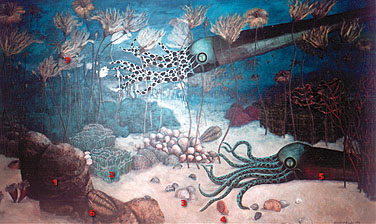 Visit
the source of this image
Visit
the source of this image
More Links: 1 - 2 - 3 - 4 - 5 - 6
Click link to return to Lecture
Schedule
or Lecture Notes by Chapter
Back to Chapter 14
Forward to Chapter 16
Case History: The Biotic Hole in the Sea
Featured
organisms:
Chambered nautilus
(Nautilus)
More Links: 1
- 2 - 3
- 4
- 5
- 6
Extinct nautiloid
relatives
 Visit
the source of this image
Visit
the source of this image
More Links: 1
- 2 - 3
- 4
- 5
- 6
Extinct ammonites
(somewhat more distant relatives)
More Links: 1 - 2
- 3
- 4 - 5
- 6
- 7
- 8
- 9
Links to cephalopod
extinction patterns:
1
- 2
- 3 -
4
- 5
- 6
- 7 -
8
After surviving a half a billion years, the few remaining
species of Nautilus may be in peril. They are being
commercially fished in some places with new technologies
and by some reports in alarming numbers. Why? For sale as
pretty shells in department stores and shell shops. This fishing
pressure could threaten the continued existence of a true
living fossil, and only living shelled relative of octopuses,
squids, and cuttlefishes. If you are interested in this topic,
read this.
RQ 15.1: Earlier in the Earth's
history, ammonites were a
conspicuous and widespread group of predators, which
went completely extinct over 65 Mya. While their
chambered relative, Nautilus, persists today as a
relatively rare group of less than 10 species, it did make
it past the extinction event that doomed the ammonites.
According to Dr. Peter Ward, how might the contrasting
modes of reproduction in nautiloids and ammonites
permitted the survival of nautiloids but not the ammonites?
I. The Dynamics of Communities
a) Ecological Succession
terms: succession, pioneer species, climax community,
climax species
b) Succession-like Processes in Marine Communities
RQ 15.2: In the boulder-strewn California
intertidal site studied
by Dr. Wayne Sousa (UCSB), different boulders could
be dominated by any one of three different algal species.
Describe the pattern of succession Sousa observed, and
then explain what likely maintained the observed
patchwork instead of dominance by a single species.
c) The Species That Play a Part in
Succession
terms: r-selected species, K-selected species, logistic equation
RQ 15.3: Briefly describe the contrasting
traits associated with
either "r-selected" or "K-selected" species.
d) Disturbance + Species Properties = Community Composition
RQ 15.4: Give an example of how
the frequency of disturbance
can influence community structure, and a separate example
of how the properties of organisms can influence community
structure.
II. The Dynamics of Populations
a) Interactions Among Organisms
terms: predation, competition, cooperation, symbiosis
(including commensalism, mutualism, parasitism),
host and parasite or pathogen
RQ 15.5: Characterize three separate
types of species interactions,
and three types of symbiosis, using examples for each.
b) How Interactions Among Organisms
Change the Sizes of
Populations
terms: endemic, territoriality (interference competition)
c) Interactions Between Organisms and the Abiotic Environment
d) The Balance Between Forces of Mortality
and Natality
terms: density-dependent
vs. density-independent mortality
III. Case Histories
a) The Crown-of-Thorns Sea Star
 Visit the source
of this image
Visit the source
of this image
Featured
organisms:
Crown-of-thorns
sea star (Acanthaster
planci)
More Links: 1
- 2 -
3
- 4 - 5
- 6
RQ 15.6: Contrast the following
two hypotheses for explaining
1960s outbreaks of numerous crown-of-thorns sea stars, which
devastated large portions of the coral reefs they grazed on:
1) Dr. Robert Endean's "snail predator" hypothesis; 2) Dr.
Charles Birkelund's episodic larval recruitment hypothesis.
Which hypothesis is best supported, and by what evidence?
How have these results been extended to apply to what
controls marine populations more generally?
b) Marine Fishes
terms (used in fisheries literature): population, stock,
recruits, recruitment
RQ 15.7: Briefly describe the life
history of herrings in the
Gulf of Maine. What is the general consensus view
for what might control the number of juvenile fish
to recruit into the population stock? Why do haddock
populations seem to have bad recruitment years when
herring have good years, and vice versa?
c) The Effects of El
Niño
terms: ENSO (= El Niño/Southern Oscillation), La Niña
1) The trade
winds weaken, the surface warms up, the
animals starve.
2) The giant
El Niño of 1982-83 was the worst of our century
[that is, until the even more
severe one in 1997-98].
More El Niño Links: 1 - 2 - 3 - 4 - 5 - 6
RQ 15.8: What causes El Niño
and what are its consequences
for the Pacific coast of North America?
3) El Niño
moves north - effects on the U.S. Pacific coast,
1982-83.
4) ENSO episodes
adjust population sizes - rarely for
short-lived organisms, frequently for long-lived species.
Click link to return to Lecture
Schedule
or Lecture Notes by Chapter
Back to Chapter 14
Forward to Chapter 16
This page created 4/29/01 © D.J. Eernisse, Last Modified 5/24/01